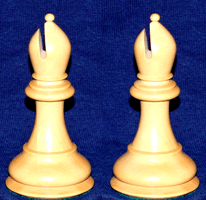
The Art of the Two Bishops
Imagining that the pieces have stable values which are written in stone is an oversimplification of chess. One of the ways to become a better player is to develop a more subtle understanding of the relative values of pieces.
Often a piece gains or loses value depending on what other material remains on the board. For instance, a queen and knight work well together, so in that case the knight might be worth more than usual. A rook becomes more important when it is your last heavy piece - i.e. you are down the exchange, or have two minor pieces against a rook. In that case you want to avoid having your last rook exchanged since then you won't be able to compete with your opponent on the ranks and files.
The same is true about bishops. A bishop gains in value when its partner is still on the board since their actions complement each other. This is the reason for the famous two-bishop advantage.
But how does one decide if the two bishops are a real advantage? And how do you evaluate a position in general - do you look down a checklist, marking off points, and you get points for possessing the bishop pair? Or are we just supposed to believe this ancient wisdom that having two bishops should give some advantage?
I think I learned a lot about assessing positions - and also about how one improves their chess in general - from a moment long ago. I was about nineteen or twenty years old and rated in the 2300s. At a tournament I was watching one game which had a position that looked similar to this:
Now, of course, I just made up that position off the top of my head, but the gist of it was that White has a large space advantage and seems to control more of the board while the black pieces were huddled on the last two ranks. I didn't look long at the position, but I just kind of assumed that White stood better because of his space advantage.
Black won the game, and afterwards I expressed surprise about this to one older master who is, by the way, a famous character in American chess circles as well as a sharp player who would certainly value dynamics and attacking potential over long-term positional factors. "I'd have taken the black pieces any day," he responded. "Those two bishops lurking back there..."
I respected him as a chess player and believed his opinion. I realized I hadn't noticed that Black had the bishop pair. "Well," I thought, "how was I supposed to notice that? I wasn't looking very seriously at the game. I just kind of glanced at it. It's not as if I was going through a checklist of positional factors - I didn't even count up the material!"
Later I realized, though, that you don't really "notice" or "not notice" the two bishops. An experienced player will just see the position and feel their power, not even needing to consciously look for them, or wonder whether they are relevant. A good player would look at the position as a whole and see each side's possibilities. Here White is seriously constrained in his own plans by the presence of the unopposed light-squared bishop bearing down the long diagonal, and must merely concentrate on preventing Black's pawn breaks such as ...b5 and ...d5.
Now let's move on to the technique of exploiting the two bishops in a queenless middlegame. Ultimately, the advantage of the bishop over the knight is its ability to move long distances. To utilize this advantage, the opposing knight (or knights) must be deprived of support points and slowly constricted. To this end, maintaining a fluid pawn structure is very important
Here is a famous example from long ago:

Of course, you don't see such games between top players today, in which one player wins as if demonstrating a theorem. Right?
Actually, the 2014 World Championship candidates began with just such an instructive game. And the contestants of that game - Viswanathan Anand and Levon Aronian - are two of the most likely challengers for Magnus Carlsen (at the time of writing, they are leading the tournament together with 5/8).
In this game, Anand got off to an incredible start, defeating his rival (who was considered a favorite to win the tournament) in this smooth manner. Of course, Aronian was under no illusions (as Englisch may have been) about the assessment of his position. But the point is that - despite advances in theory, new openings, new understandings of dynamics - the players of today are battling with the same tools as were used in 1883 and earlier. Now let's look at Anand's instructive exploitation of his bishop pair.

This game shows Anand's great strengths - a healthy classical style and an excellent exploitation of the advantage. In general, utilizing the two bishops demands a lot of work in stifling counterplay and keeping control, while the side with the knight needs to try to upset the position at all costs. The side with the bishops is trying to maintain order and build up the position slowly, while the knight is trying to create chaos. While in general it is easier to break down than to build up, in positions such as this, truth is on the side of the player with the bishops, even if it takes a strong player to show it.
RELATED STUDY MATERIAL
- Read GM Julio Becerras' article about the Janowski Bishops;
- Learn how to dominate a knight with your bishop in Chess Mentor;
- Maintain your tactical brilliance in Tactics Trainer;
- Watch GM Dejan Bojkov's analysis of Steinitz vs. Englisch in Greatest Chess Minds: Wilhelm Steinitz - Part 6.



